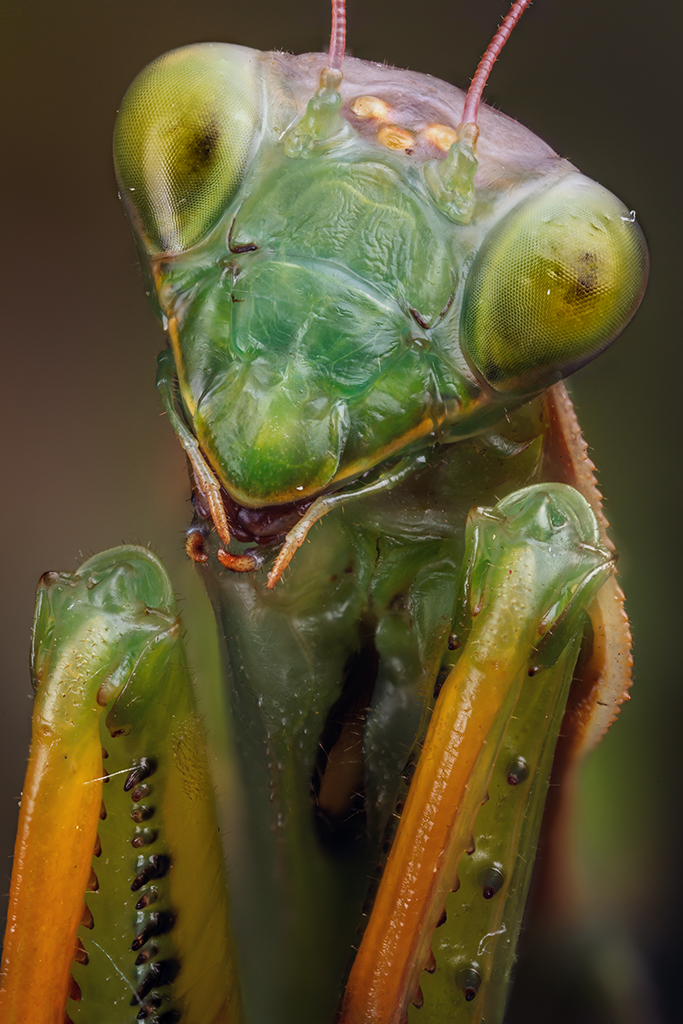ShopDreamUp AI ArtDreamUp
Deviation Actions
Description
Portrait of a Fully matured female European Mantis (Mantis religiosa).
This was shot hand held as a deep focus stack compiled from 39 optical slices at f/5.6.
Needless to say this took a tremendous amount of time to process....
With a wider aperture focus stack a lot of fine detail is captured in an image. Here are some 100% cropped details.
[link]
Pictured here is the dorsal region of the head. The three triangular positioned lumps are simple eyes known as the Dorsal ocelli. Their lenses have a very low refractive value (very low resolving power) but wide field of view with a wide aperture. Light from the lenses are focused to a photosensitive layer that have a dedicated optical connection. These eyes focus a lot of light making them great for measuring variations in light intensity.
[link]
Pictured here is a close up of the compound eye. The hexagonal facets are the ommatidia which a mantis has ~10,000 per compound eye. An ommatidium is a dedicated picture element containing a cornea and cone which focus light down a rod known as the rhabdom eventually striking a layer of photoreceptors. Each ommatidium has it's own axonal connection. Combined these 10,000 picture elements are processed by the insect brain to give them their wide field of vision they use when hunting. The darker spot on the eye is called a pseudopupil and is caused by those ommatidia absorbing the incident light reflected from the observer.
[link]
Pictured here is a closeup of the clypeus region of the insect head getting near the mouth parts. The branching lines underneath the exoskeleton are nerve bunches. They possibly connect the clypeus/labrum to the supraesophageal ganglion (a portion of the insects nervous system).
[link]
Pictured here is a close up of the labium region of the chewing mouth parts. The mouth parts contain powerful muscles with teeth capable of grinding their prey up. The hairy appendages are the maxillary palps a segmented organ used for sensory.
[link]
Pictured here is an individual spine from the raptorial prothoracic legs. These powerful forelegs with the help of those spines create a powerful grip to their prey.
This was shot hand held as a deep focus stack compiled from 39 optical slices at f/5.6.
Needless to say this took a tremendous amount of time to process....
With a wider aperture focus stack a lot of fine detail is captured in an image. Here are some 100% cropped details.
[link]
Pictured here is the dorsal region of the head. The three triangular positioned lumps are simple eyes known as the Dorsal ocelli. Their lenses have a very low refractive value (very low resolving power) but wide field of view with a wide aperture. Light from the lenses are focused to a photosensitive layer that have a dedicated optical connection. These eyes focus a lot of light making them great for measuring variations in light intensity.
[link]
Pictured here is a close up of the compound eye. The hexagonal facets are the ommatidia which a mantis has ~10,000 per compound eye. An ommatidium is a dedicated picture element containing a cornea and cone which focus light down a rod known as the rhabdom eventually striking a layer of photoreceptors. Each ommatidium has it's own axonal connection. Combined these 10,000 picture elements are processed by the insect brain to give them their wide field of vision they use when hunting. The darker spot on the eye is called a pseudopupil and is caused by those ommatidia absorbing the incident light reflected from the observer.
[link]
Pictured here is a closeup of the clypeus region of the insect head getting near the mouth parts. The branching lines underneath the exoskeleton are nerve bunches. They possibly connect the clypeus/labrum to the supraesophageal ganglion (a portion of the insects nervous system).
[link]
Pictured here is a close up of the labium region of the chewing mouth parts. The mouth parts contain powerful muscles with teeth capable of grinding their prey up. The hairy appendages are the maxillary palps a segmented organ used for sensory.
[link]
Pictured here is an individual spine from the raptorial prothoracic legs. These powerful forelegs with the help of those spines create a powerful grip to their prey.
Image size
683x1024px 612.75 KB
© 2012 - 2024 lord-creeper
Comments24
Join the community to add your comment. Already a deviant? Log In
Probably a warrior, judging by the state of the left eye. Great shot!


































